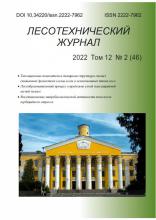Voronezh, Voronezh, Russian Federation
Voronezh, Voronezh, Russian Federation
Voronezh, Voronezh, Russian Federation
One of the topical issues of the application of furniture in domestic premises is defining its limiting (maximum) saturation in the premises so that the air in these premises, the allocation of harmful substances does not exceed the maximum allowable level (maximum permissible concentrations - MPC). It is known that in using furniture of wood-based panels (particle Board, Chipboard, wood fiber, MDF) this substance is formaldehyde. Currently, the MoH established the formaldehyde MPC in the air at the level of 0.01 mg/m3. The aim of this work was to determine the limit of saturation with the wood plates in premises, provided that indoor formaldehyde emissions from plates will not exceed the established by the Ministry of health MPC. This definition of the limit of saturation (Ls, m2 of plates/m3 of the premises air) was performed according to our previously derived formula. Calculations were made for furniture (cabinet furniture, tables, beds of panel design, furniture for sitting and lying, beds with soft headboards and elements), floor coverings and wall panels. In the result, it was found that, for example, when using chipboard of E1 formaldehyde emission class in designs of furniture, tables, beds of panel construction value of Ls when the IISP is 1.0 m2/m3 of air (saturation of the volume of air with plates in their testing by chamber method) and MPC=0.01 mg/m3 is 4.03 m2 /room, and when MPC=0.124 mg/m3 (adopted by the countries-participants of the WTO and the World Health Organization) it will make 50.05 m2/room. When using plates of the same emission class, and for the same value of IISP, when MPC=0.01 mg/m3 Ls value is 6.25 m2 /room, when MPC=0.124 mg/m3 it will make 77.63 m2 /room. When using E1 class chipboard panels in the construction of furniture for sitting and lying, beds with soft headboards and elements, Ls value in the IISP is equal to 0.3 m2/m3 air and at MPC=0.01 mg/m3 is of 1.21 m2 /room, and when MPC=0.124 mg/m3 it will make 15.02 m2/room. When using plates of the same emission class, and for the same value of IISP at Mac=0.01 mg/m3 Ls value is 1.88 m2/room, when MPC=0.124 mg/m3 it will make 23.45 m2/room.
Saturation limit of the air volume of the room, formaldehyde, chipboard.
По действующим на ДСтП стандартам (ГОСТ 10632-2014 и ГОСТ 32289-2013) [1, 2] предусмотрен выпуск неламинированных плит классов эмиссии формальдегида Е0,5; Е-1 и Е-2 (табл. 1) и ламинированых – классов Е-1 и Е-2 (табл. 2), для которых установлены свои нормы выделения формальдегида при испытании плит перфораторным или камерным методами.
1. GOST 10632-2014. Plity drevesno-struzhechnye. Harakteristiki [State Standard. Plates are wood-shaving. Specifications] (In Russian).
2. GOST 32289-2013. Plity drevesno-struzhechnye, oblicovannye plenkami na osnove termoreaktivnyh polimerov. Tehnicheskie uslovija (EN 438-2:2005, NEQ) [State Standard. Plates are wood-shaving, revetted with films on the basis of thermoreactive polymers. Specifications (EN 438-2:2005, NEQ] (In Russian).
3. GOST 30255-2014. Mebel', drevesnye i polimernye materialy Metod opredelenija vydele-nija formal'degida i drugih vrednyh letuchih himicheskih veshhestv v klimaticheskih kamerah [Furniture, wood and polymeric materials. A method of definition of release of formaldehyde and other harmful flying chemicals in climatic chambers] (In Russian).
4. Gigienicheskie normativy GN 2.1.6.1338-03 (s izmenenijami na 12 janvarja 2015 goda) «Predel'no dopustimye koncentracii (PDK) zagrjaznjajushhih veshhestv v atmosfernom vozduhe naselennyh mest» [Hygienic standards of GN 2.1.6.1338-03 (with changes for January 12, 2015) "The Maximum Permissible Concentration (MPC) of the polluting substances in atmospheric air of the inhabited places". Are approved as the state health officer of the Russian Federation]. (In Russian).
5. GOST 12.1.007. Sistema standartov bezopasnosti truda. Vrednye veshhestva. Klassifikacija i obshhie trebovanija bezopasnosti [Occupational safety standards system. Harmful substances. Classification and general safety requirements] (In Russian).
6. Liu W.Q. Yang H.F. Dong F.Q. [et al.] Experimental study on flexural behavior of glulam and laminated veneer lumber beams. Modern bamboo structures: Conference: 1st International Conference on Modern Bamboo Structures Location: Hunan Univ, Changsha, peoples r china Date: OCT 28-30, 2007, 2008, pp. 159-169.
7. Kol H.S., Keskin H., Korkut S., Akbulut T. Laminated veneer lumber from Rowan (Sorbusaucuparia- Lipsky). African journal of agricultural research. OCT 2009, pp.1101-1105.
8. Artamonov B.I., Bukhtiyarov V.P., Velk A.A., Kuznetsov V.E., Novak G.K., Panova T.N. [i dr.] Spravochnik mebel'shchika [Reference book of the furniture maker]. Moscow, 2005, 600 p. (In Russian). EDN: https://elibrary.ru/QNJGRD
9. Razinkov E.M., Ishhenko T.L. Snizhenie toksichnosti drevesnyh plit i kleenyh materialov [Decrease in toxicity of wood plates and glued materials (monograph, Germany)] Palmarium Academic PublishingIs a trademark of:AV Akademikerverlag GmbH Co. KGHeinrich-Bocking-Str. 6-8-66121, Saarbrucken.Germany EDN: https://elibrary.ru/XBTXBH
10. Razinkov E.M. Promyshlennoe proizvodstvo malotoksichnyh drevesnostruzhechnyh plit [Industrial production of low-toxic wood chipboards] Prirodopol'zovanie: resursy, tehnicheskoj obespechenie [Environmental management: resources, technical providing]. Voronezh, 2009, pp 121-128. (In Russian). EDN: https://elibrary.ru/PYXSJW












